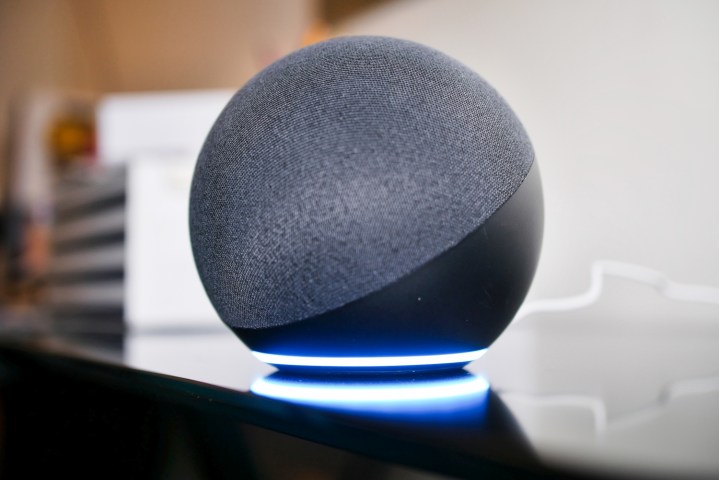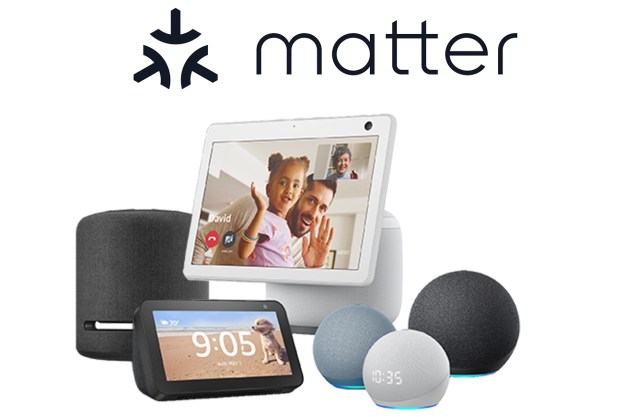Tired of your outdoor smart lights and security cameras constantly losing network connectivity? Luckily, there’s now an answer to these infuriating dropped connections, and it’s all thanks to Amazon. Announced in September 2019, Amazon Sidewalk finally goes live on June 8. In a nutshell, Sidewalk is Amazon’s take on community network expansion. Utilizing a tiny parcel of your home’s Wi-Fi network and select smart home devices, Sidewalk will broadcast data using Bluetooth Low Energy (BLE) and the 900MHz spectrum, employing several Echo and Ring devices at launch for the actual broadcasting. The end result: Faster device setups, stronger, more consistent wireless connections, and expanded networking for entire neighborhoods and communities.
The building blocks of Sidewalk

By default, a bevy of Amazon Echo and Ring devices will be capable of Bluetooth Low Energy (BLE) broadcasting when Sidewalk goes live. These are the data frequencies used for improved device performance within the four walls of our homes, detached garages, patios, and backyards, and the tech we operate on our properties (more on that in a bit). At launch, only the fourth-gen Amazon Echo speaker, Echo Show 10, Ring Floodlight Cam, and Ring Spotlight Cam Wired will be capable of both BLE and 900MHz broadcasting — the latter being the critical component of a successful Sidewalk experience for your locale. The 900MHz spectrum is what Sidewalk Bridge devices will use to transmit signals up to half a mile away.
While Sidewalk will only snatch up a fraction of your home’s Wi-Fi (up to 500MB per month) to blast out these wide-reaching community signals, it is possible to disable Sidewalk if you’re not up for sharing any part of your bandwidth. That being said, the more households with enabled Sidewalk Bridge devices, the better for your zip code.
To further illustrate the benefits of Amazon Sidewalk, we’ve broken down the average smart home into five different Alexa-friendly device tiers — each of which can/will be directly impacted by Sidewalk’s expanded network coverage and improved hardware performance.
Do note that not all suggested device tiers will be compatible with Sidewalk networking at launch. What we’re presenting is more of an imagined future for the new Amazon technology.
Speedier Alexa response times

Smart speakers and displays are fundamental (borderline necessary) tools for running your smart home. Alexa-powered voice assistant devices can check news/weather, play music and podcasts, set timers, help you converse with family and friends, adjust the temperature in your home, and more. A crucial part of any smart home ecosystem, the downfall of devices like Amazon Echo speakers and Alexa-friendly thermostats like the Ecobee SmartThermostat becomes apparent when there are too many devices on your Wi-Fi. Symptoms of a bogged-down network can include slow responsiveness to voice commands, poor command execution, and/or dropped connections. While dual-band and mesh router systems can help to beef up your Wi-Fi, Amazon Sidewalk will elevate your voice assistant experience to the next level.
For starters, if you’re running an Echo-exclusive household, Amazon’s entire lineup of smart speakers will be capable of passing data over Sidewalk’s BLE spectrum. Look forward to your Echo speakers performing better than ever before. The BLE spectrum will help to get your new Alexa speakers (and related Alexa gear) up and running quickly while maintaining an improved level of overall functionality. Think faster web searching, lightning responses to your voice commands, and execution of your spoken demands.
Additionally, if you’re agreeing to siphon off some Wi-Fi, or find yourself on the receiving end of your neighbor’s Sidewalk Bridge broadcast, you can expect fewer signal dropouts altogether, thanks to the data-sharing powers of the 900MHz long-range spectrum.
Lights can stay on when a network goes down

Philips Hue lighting kits, Serena Lutron shades, and Chamberlain smart garage openers all have one thing in common: They’re each home automation add-ons that elevate the way you live in your house and manage your lifestyle. Like any web-connected gear, these are all components that rely on your Wi-Fi to execute even their most basic functions. So what happens if the power gets knocked out to your community? Without a network connection, there’s simply no way to manage automation gear, on the go or at home. This is where Sidewalk will come into play.
On an average day where Wi-Fi is up and running, Sidewalk will help take the weight off your router by keeping your smart lights and other automation tools connected over the BLE spectrum. This is especially useful for home-adjacent devices like garage door openers that may not receive the greatest Wi-Fi signal in the first place. With Sidewalk, users of automation gear can expect things like smart lighting, certain shades and thermostats, and various garage door openers to respond faster to in-app and spoken word commands.
Now the worst-case scenario: If a summer storm rolls through and knocks out electricity to the entire neighborhood, your internet service provider (ISP) may be behind in restoring Wi-Fi when power returns to your home. With Sidewalk in place, your essentials may be able to jump on the Sidewalk 900MHz waves to get online before your ISP climbs the pole to make repairs.
Continued access to smart locks and video doorbells

There’s no shortage of smart locks and video doorbells on the market. Once paired to Wi-Fi, these devices allow you to remotely lock/unlock your doors, grant guest codes to friends and family, set schedules based on your day-to-day, see who’s at the door, receive motion alerts, communicate via two-way audio chat, and more. All great features, all reliant on Wi-Fi to work…. until Sidewalk, that is.
Level, a smart lock brand, will be amongst the first smart locks compatible with Sidewalk networking. Previously, a Level lock could only be controlled using an Apple HomeKit system or through Bluetooth by mobile phone. With Sidewalk integration, Level owners will be able to check lock status remotely and toggle locks on/off as long as the phone has an internet connection. Better yet, Sidewalk will also allow Level locks to be paired with the Ring Video Doorbell Pro, allowing you to lock/unlock your doors and see who rang the bell, all through the Ring app.
Corner to corner home security peace of mind

Next to the Amazon Echo lineup, Ring’s product suite is a second major wing of Amazon-owned devices that will directly benefit from Sidewalk’s network capabilities. Right out of the gate, the Ring Floodlight Cam and the Ring Spotlight Cam Wired will be two of the four Sidewalk Bridge devices available at launch. To reiterate, this means that the Floodlight and Spotlight will be capable of broadcasting data over both the BLE and 900MHz spectrums.
For homeowners that have invested in smart security or are thinking of doing so, having a backup network at the ready is never a bad thing. In situations where Wi-Fi reach is spotty for outdoor cameras and floodlights, Sidewalk will help pick up the slack by providing a quicker and cleaner A-to-B handshake from your router to your outdoor tech. Not to mention if your Wi-Fi completely tanks for a while, Sidewalk may be able to save the day by providing a lifeline network for your security gear to pair with while you and/or your ISP sort out your Wi-Fi issues.
While Ring hardware is one of the only home security brands that will benefit from Sidewalk at launch, we can easily imagine a near future where third-party cameras, motion sensors, and other home security brands are supported by Sidewalk’s expanded networking.
Tracking down missing items will be easier

Sick of your losing your keys and wallet? That’s what Tile is for. The Bluetooth-enabled tracking devices are an excellent way to keep tabs on your most valuable items, but tracking was initially limited to a handshake between your phone’s Bluetooth receiver and Tile’s transmission. Now, with expanded Sidewalk coverage, Tile trackers will be able to hop aboard Amazon’s community network for further-reaching capabilities. Users will also be able to ask Alexa to locate their Tile-tracked valuables with voice commands.
Beyond Tile, the future of Sidewalk tracking functions is bright. Currently, Amazon is partnered with CareBand, a wearables company for those suffering from dementia. Using the Sidewalk network, CareBand devices will be able to operate far beyond the typical Wi-Fi range, with all CareBand features still available over the Sidewalk network.
Editors' Recommendations
- Here’s how to throw a killer Halloween party with your smart home
- I tried the Amazon Echo Show 8, a smart display that transforms when you get close
- Amazon’s Echo family expands with an on-wall hub, smart glasses, and more
- Amazon to pay $30M in FTC settlements over Alexa, Ring privacy violations
- The underappreciated Amazon Sidewalk network is bigger than you think



